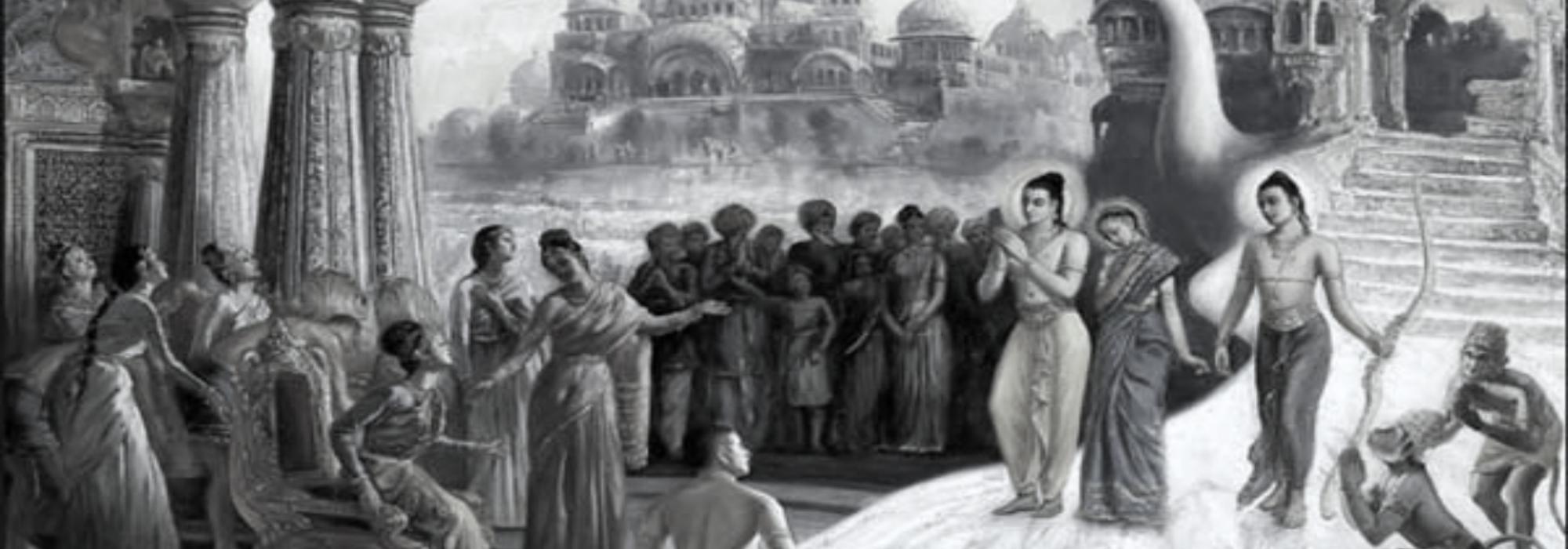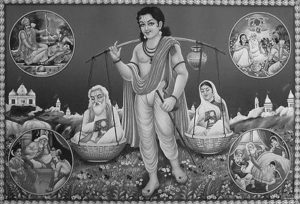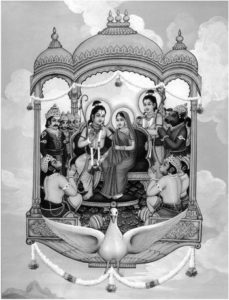Kālidāsa is known as the master of similes. The Sanskrit tradition has proclaimed it as ‘Upamā Kālidāsasya.’ The variety, depth and appropriateness of his similes remains unsurpassed to this day. A study of his similes is itself an education in many branches of knowledge. Instead of confining ourselves strictly to the similes, we can look at the superset called sādṛṣyamūlālaṅkāra. Dṛṣṭānta (Analogy) and atiśayokti (hyperbole) also fall into the same category. The following selection from his works will be a veritable treat to rasikas.
Meghadūtam
Despite being a short lyrical poem, the quality of similes in Meghadūtam is of a very high order. We can have a look at a few of them.
येन श्यामं वपुर् अतितरां कान्तिम् आपत्स्यते
ते बर्हेणेव स्फुरितरुचिना गोपवेषस्य विष्णोः ॥
The cloud with the rainbow across its dark grey body appears like Lord Krishna with a peacock feather on his head
रेवां द्रक्ष्यस्युपलविषमे विन्ध्यपादे विशीर्णां
भक्तिच्छेदैरिव विरचितां भूतिमङ्गे गजस्य ॥
The Amrakantak hill with river Narmada flowing down in multiple streams appears like a big elephant with its body painted in white stripes.
शिप्रावातः प्रियतम इव प्रार्थनाचाटुकारः ॥
The early morning breeze blowing over the river Shipra in Ujjain is like a lover flattering his loved one with requests to wake up.
एकं मुक्तागुणमिव भुवः स्थूलमध्येन्द्रनीलम् ॥
For the gods above, the river Charmaṇvati with the cloud above it, appears like a necklace of pearls adorned with an Indranīlamaṇi at the centre.
Raghuvaṃśam
This is the work where Kālidāsa reaches his zenith in terms of similes. In this work, he provides strikingly apt similes drawn from such diverse areas as mythology, agriculture, grammar, nature, scriptures, astrology, statecraft, and of course, day-to-day life. His mastery over each one of these branches is aptly represented by his similes. Beyond strict similes, he has given us some wonderful examples of dṛṣṭānta, utprekṣā and atiśayokti also. They are all basically rooted in comparison like the simile. Hence, we shall include them also in our examples.
मन्दः कवियशः प्रार्थी
गमिष्याम्युपहास्यताम् |
प्रांशुलभ्ये फले लोभाद्-
उद्बाहुरिव वामनः ||
Me, the dullard, who is yearning for poetic fame will be made fun of just like a short man jumping to reach for a fruit hanging high up.
तं सन्तः श्रोतुमर्हन्ति
सदसद्व्यक्तिहेतवः |
हेम्नः संलक्ष्यते ह्यग्नौ
विशुद्धिः श्यामिकापि वा ||
This work (Raghuvaṃśam) shall be read by those who can differentiate between right and wrong. The purity or the lack of it in gold is determined only when it is subjected to fire.
भीमकान्तैर्नृपगुणैः
स भभूवोपजीविनाम् |
अधृष्यश्चाभि गम्यश्च
याधोरत्नैरिवार्णवः ||
King Dilīpa was welcoming as well as intimidating. He was intimidating for the immoral but welcoming for the needy. He was like the sea which is intimidating because of the dangerous animals that inhabit it but which is also welcoming because of the great riches it has inside.
इति विज्ञापितो राज्ञा
ध्यानस्तिमितलोचनः |
क्षणमात्रम् ऋषिस्तस्थौ
सुप्तमीन इव ह्रदः ||
Upon the king’s request, sage Vasiṣṭha, with his eyes closed, sank into dhyāna for a moment. At that moment, he appeared as still as a pond whose fishes are sleeping.
स सेनां महतीं कर्षन्
पूर्वसागरगामिनीम् |
बभौ हरजटाभ्रष्टां
गङ्गामिव भगीरथः ||
King Raghu, leading his great army, appeared like King Bhagīratha leading the river Gaṅga towards the Eastern sea.
This simile is very appropriate because King Raghu will be heading towards the East on his conquest.
आपादपद्मप्रणताः
कलमा इव ते रघुम् |
फलैः संवर्धयामासुर्-
उत्खातप्रतिर्पिताः ||
They (the Vaṅgas), having submitted to Raghu and being reinstalled in their domains, bore rich fruits for Raghu. It was like displacing the tender rice sapling from one side of the paddy field into the other and reaping rich benefits.
This is an actual agricultural process and is very apt for the situation.
कामं नृपाः सन्तु सहरशोऽन्ये
राजन्वतीमाहुरनेन भूमिम् |
नक्षत्रताराग्रहसंकुलापि
ज्योतिष्मती चन्द्रमसैव रात्रिः ||
There may be many kings on earth. But only this king (Parantapa, king of Magadha) makes the earth feel proud. Even though there are numerous stars in the sky, the night feels bright only because of the moon.
सञ्चारिणी दीपशिखेव रात्रौ
यं यं व्यतीयाय पतिंवरा सा |
नरेन्द्रमार्गाट्ट इव प्रपेदे
विवर्णभावं स स भूमिपालः ||
In the svayaṃvara, as Indumati approached each king his face glowed with expectation and excitement. But as she moved on without choosing them, their faces became pale and dejected.
Kālidāsa compares this to the flame of a lamp passing through the main city-street, illuminating each home as it approaches it and leaving behind it in darkness as it moves forward. For this brilliant simile, the Indian literary tradition fondly assigned him the honorific title ‘Dīpaśikhā Kālidāsa.’
दृष्ट्या प्रसादामलया कुमारं
प्रत्यग्रहीत्संवरणस्रजेव ||
Indumati accepted prince Aja with a pleasant twinkle in her eyes. It was as if her look itself had become the garland of marriage.
ता राघवं दृष्टिभिरापिबन्त्यो
नार्यो न जग्मुर्विषयान्तराणि |
तथा हि शेषेन्द्रियवृत्तिरासां
सर्वात्मना चक्षुरिव प्रविष्टा ||
When King Aja returned after marrying Indumati, the women of the city forgot everything else and lined up to gaze at him with unabashed admiration. It was as if all their other senses were invested in their eyes only.
अथ तस्य विवाहकौतुकं
ललितं बिभ्रत एव पार्थिवः |
वसुधामपि हस्तगामिनीम्
अकरोदिन्दुमतीमिवापराम् ||
Even as Aja was celebrating his marriage with Indumati, his father, King Raghu, handed over the kingdom to him as if he was handing over another Indumati.
अनुभूय वसिष्ठसंभृतैः
सलिलैस्तेन सहाभिषेचनम् |
विशदोच्छवसितेन मेदिनी
कथयामास कृतार्थतामिव ||
The sacred waters by which sage Vasiṣṭha performed the coronation of King Aja fell on to the ground. The aroma that arose from the ground was like the earth heaving its sigh of relief for having gotten Aja as the king.
Now, we shall see the reaction of Daśaratha to the curse pronounced by the blind father of Śravaṇakumāra, who gets killed by the king on a hunting mission. The curse was that Daśaratha would suffer separation from his son in his old age.
शापोऽप्यदृष्टतनयाननपद्मशोभे
सानुग्रहो भगवता मयि पातितोऽयम् |
कृष्यां दहन्नपि खलु क्षितिमिन्धनेद्धो
बीजप्ररोहजननीं ज्वलनः करोति ||
“Revered sir, for me who has not been fortunate to have seen the lovely face of my own child so far, even this curse of yours is a blessing; at least now I’m sure to be blessed by a child. Your curse is like the forest fire which, despite burning the forest to ashes, only ends up making it fertile for another bloom.”
सा पौरान् पौरकान्तस्य
रामस्याभ्युदयश्रुतिः |
प्रत्येकं ह्लादयां चक्रे
कुल्येवोद्यानपादपान् ||
The news of Rama’s coronation brought immense joy to each one of his adoring citizens of Ayodhya. It was like a canal which waters the trees in the gardens, filling the water bund created for one tree before moving on to the other and so on and so forth.
This is also very apt – it essentially means that the citizens, overflowing with joy, spread the news from one to the other.
सा किलाश्वासिता चण्डी
भर्त्रा तत्संश्रुतौ वरौ |
उद्ववामेन्द्रसिक्ता भूर्-
बिलमग्नाविवोरगौ ||
The two wishes that the stubborn queen Kaikeyi extracted from Daśaratha were like two serpents emanating from their burrows after the rains.
To be noted is the aptness in mentioning the time – it is only after the rains that the snakes enjoy coming out. They will be closeted inside their burrows in the summer to avoid extreme heat.
इतस्ततश्च वैदेहीम्
अन्वेष्टुं भर्तृचोदिताः |
कपयश्चेरुरार्तस्य
रामस्येव मनोरथाः ||
Just like the grief-stricken Rāma’s wandering thoughts, the army of monkeys sent forth by Sugrīva looked for Sītā in every place possible.
The aptness of this simile should not be missed. Just like there is no place out of reach of thoughts, there was no place that the monkeys did not reach.
मारुतिः सागरं तीर्णः संसारमिव निर्ममः ||
Hanūmān prevailed over the perils of the sea just like a sage would prevail over the perils of life.
The depth and aptness of this simile cannot be overemphasized.
दृष्टा विचिन्वता तेन
लङ्कायां राक्षसीवृता |
जानकी विषवल्लीभिः
परीतेव महौषधिः ||
Hanūmān, looking for Sītā in Laṅkā, found her surrounded by rākṣasis. She appeared like a great medicinal plant surrounded by poisonous creepers.
प्रत्यभिज्ञानरत्नं च
रामायादर्शयत्कपी |
हृदयं स्वयमायातं
वैदेह्या इव मूर्तिमत् ||
The recognition-ring that Sītā had sent with Hanūmān was duly presented by Hanūmān to Rāma as if he had brought with him the very heart of Sītā.
निर्विष्टमुदधेः कूले
तं प्रपेदे विभीषणः |
स्नेहाद्राक्षसलक्ष्म्येव
बुद्धिमादिश्य चोदितः ||
While Rāma was camping on the sea-side on his way to Laṅkā, he was approached by Vibhīṣaṇa, the younger brother of Rāvaṇa. It was as if the patron-goddess of Laṅkā had intimately advised him to do it for his own good.
स सेतुं बन्धयामास
प्लवगैर्लवणाम्भसि |
रसातलादिवोन्मग्नं
शेषं स्वप्नाय शार्ङ्गिणः ||
Rāma got a bridge built over the sea. It appeared as if the great serpent Ādiśeṣa had risen from under to facilitate the sleep of Lord Viṣṇu.
अकाले बोधितो भ्रात्रा
प्रियस्वप्नो वृथा भवान् |
रामेषुभिरितीवासौ
दीर्घनिद्रां प्रवेशितः ||
The arrows of Rāma sent mighty Kumbhakarṇa to eternal sleep as if telling him – “O sleep-loving Kumbhakarṇa, you were unduly woken up by your brother Rāvaṇa for no good reason.”
भुजमूर्धोरुबाहुल्याद्-
एकोऽपि धनदानुजः |
ददृशे सोऽयथापूर्वो
मातृवंश इव स्थितः ||
Because of his many arms, heads and legs, Rāvaṇa, though alone, appeared like the entire race of demons lined up.
Further, Kālidāsa describes the aerial view from the divine puṣpakavimāna when Rāma and Sītā are returning to Ayodhya after killing Rāvaṇa. Some of the similes served up in that section are worth mentioning.
वैदेहि! पश्यामलयाद् विभक्तं
मत्सेतुना फेनिलमम्बुराशिम् |
छायापथेनेव शरत्प्रसन्नम्
आकाशमाविष्कृतचारुतारम् ||
Sītā! Look at the bridge constructed by me; it divides the sea all the way from the Malayā (Sahyādri) mountain till Laṅkā. It appears to me like the Milky Way across a star-lit autumn night.
सैषा स्थली यत्र विचिन्वता त्वां
भ्रष्टं मया नूपुरमेकमुर्व्याम् |
अदृश्यत त्वच्चरणारविन्द-
विश्लेषदुःखादिव बद्धमौनम् ||
It was in this very place, while searching for you, that I found an anklet which had slipped off you. It appeared to me as if it was in distress at losing the company of your lotus feet and had hence gone quiet.
एतन्मुनेर्मानिनि शातकर्णेः
पञ्चाप्सरो नाम विहारवारि |
आभाति पर्यन्तवनं विदूरान्
मेघान्तरालक्ष्यमिवेन्दुबिम्बम् ||
Sītā! This is lake Pañcāpsara, surrounded by the forest on all sides, where the sage Śātakarṇi moves about. From this distance, it appears like the moon peeking from among the clouds.
छायाविनीताध्वपरिश्रमेषु
भूयिष्ठसंभाव्यफलेष्वमीषु |
तस्यातिथीनामधुना सपर्या
स्थिता सुपुत्रेष्विव पादपेषु ||
With sage Śarabhaṅga gone, the duty of welcoming and serving the guests is now vested in the trees of his hermitage, which bear fruits and provide shade, comforting the passers-by. It is like the duties of a father being owned up by his able sons.
The final simile in the Rāmāyaṇa section is also fascinating.
निर्वर्त्यैवं दशमुखशिरश्छेदकार्यं सुराणां
विष्वक्सेनः स्वतनुमविशत्सर्वलोकप्रतिष्ठाम् |
लङ्कानाथं पवनतनयं चोभयं स्थापयित्वा
कीर्तिस्तम्भद्वयमिव गिरौ दक्षिणे चोत्तरे च ||
Thus, having killed Rāvaṇa, Rāma dissolved himself into his original form. Before he went, he had established Hanūmān on the Himalayas, and Vibhīṣaṇa on the Trikūṭa hill in Laṅkā. They were like two victory towers proclaiming Rāma’s greatness.
This simile is very apt because, in our tradition, Hanūmān and Vibhīṣaṇa are considered as immortals. And hence, this simile implies that Rāma’s victory towers will be there for all time proclaiming his greatness.
We can conclude the Raghuvaṃśam fest with a couple of sobering similes from the description of the irresponsible king Agnivarṇa.
व्योम पश्चिमकलास्थितेन्दु वा
पङ्कशेषमिव घर्मपल्वलम् |
राज्ञि तत्कुलमभूत्क्षयातुरे
वामनार्चिरिव दीपभाजनम् ||
Like the sky a day before the new moon day, like a lake reduced to marsh during summer and like the dying flame of a lamp grazing the lamp itself, the solar race had come to the brink of extinction when Agnivarṇa fell ill (without a son to take the race forward).
वैद्ययत्नपरिभाविनं गदं न प्रदीप इव वायुमत्यगात् ||
Despite the best efforts of the doctors, the king could not be rescued from the disease. It was like a lamp getting blown off by the wind.
To be continued.
















































